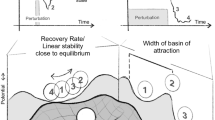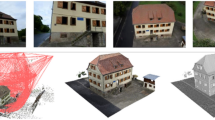Abstract
In multivariate spatio-temporal Geostatistics, direct and cross-correlations among the variables of interest are measured by the matrix-valued covariance function. In this paper, a new and complete procedure useful for selecting an appropriate spatio-temporal linear coregionalization model (ST-LCM) with suitable models for the basic components is proposed. Thus, after detecting the spatio-temporal correlation of the latent components, through simultaneous diagonalization of the sample covariance matrices, some essential characteristics of each component are tested so that an aware choice for basic covariance models can be made. In the literature, some statistical tests to assess separability and symmetry of the covariance matrix, as well as the adequacy of the LCM were proposed; however in this paper further aspects on the basic components are investigated. All steps of the proposed procedure for analyzing and modeling the components of an ST-LCM are discussed in a case study where a very large spatio-temporal data set, concerning two environmental variables, is considered.





Similar content being viewed by others
References
Alegría A, Porcu E, Ferrer R (2018) Asymmetric matrix valued covariances for multivariate random fields on spheres. J Stat Comput Simul 88(10):1847–1849
Apanasovich TV, Genton MG (2010) Cross-covariance functions for multivariate random fields based on latent dimensions. Biometrika 97(1):15–30
Apanasovich TV, Genton MG, Sun Y (2012) A valid Matérn class of cross-covariance functions for multivariate random fields with any number of components. J Am Stat Assoc 107:180–193
Babak O, Deutsch CV (2009) An intrinsic model of coregionalization that solves variance inflation in collocated cokriging. Comput Geosci 35(3):603–614
Bevilacqua M, Gaetan C, Mateu J, Porcu M (2012) Estimating space and space-time covariance functions for large data sets: a weighted composite likelihood approach. J Am Stat Assoc 107(497):268–280
Bevilacqua M, Hering AS, Porcu E (2015) On the flexibility of multivariate covariance models: comment on the paper by Genton and Kleiber. Stat Sci 30(2):167–169
Bornn L, Shaddick G, Zidek JV (2012) Modeling nonstationary processes through dimension expansion. J Am Stat Assoc 107:281–289
Bourotte M, Allard D, Porcu E (2016) A flexible class of non-separable cross-covariance functions for multivariate space-time data. Spat Stat 18:125–146
Brown P, Karesen K, Tonellato GORS (2000) Blur-generated nonseparable space-time models. J R Stat Soc Ser B 62(Part 4):847–860
Cappello C, De Iaco S, Posa D (2018a) Testing the type of non-separability and some classes of space-time covariance function models. Stoch Environ Res Risk Assess 32:17–35
Cappello C, De Iaco S, Maggio S, Posa D (2018b) Isotropy, symmetry, separability and strict positive definiteness for covariance functions: a critical review. Spat Stat 29:89–108
Cardoso JF, Souloumiac A (1996) Jacobi angles for simultaneous diagonalization. SIAM J Math Anal Appl 17:161–164
Castruccio S, Genton MG (2014) Beyond axial symmetry: an improved class of models for global data. Stat 3:48–55
Choi J, Fuentes M, Reich BJ, Davis JM (2009) Multivariate spatial-temporal modeling and prediction of speciated fine particles. J Stat Theory Pract 3(2):407–418
Cressie N, Huang H (1999) Classes of nonseparable, spatial-temporal stationary covariance functions. J Am Stat Assoc 94(448):1330–1340
Daley DJ, Porcu E, Bevilacqua M (2015) Classes of compactly supported covariance functions for multivariate random fields. Stoch Environ Res Risk Assess 29:1249–1263
De Iaco S, Posa D (2013) Positive and negative non-separability for space-time covariance models. J Stat Plan Inference 143:378–391
De Iaco S, Posa D (2018) Strict positive definiteness in geostatistics. Stoch Environ Res Risk Assess 32:577–590
De Iaco S, Myers DE, Posa D (2001) Space-time analysis using a general product-sum model. Stat Probab Lett 52(1):21–28
De Iaco S, Myers DE, Posa D (2003) The linear coregionalization model and the product-sum space-time variogram. Math Geol 35(1):25–38
De Iaco S, Palma M, Posa D (2005) Modeling and prediction of multivariate space-time random fields. Comput Stat Data Anal 48(3):525–547
De Iaco S, Myers DE, Palma M, Posa D (2010) FORTRAN programs for space-time multivariate modeling and prediction. Comput Geosci 36(5):636–646
De Iaco S, Maggio S, Palma M, Posa D (2012) Towards an automatic procedure for modeling multivariate space-time data. Comput Geosci 41:1–11
De Iaco S, Myers DE, Palma M, Posa D (2013a) Using simultaneous diagonalization to identify a space-time linear coregionalization model. Math Geosci 45:69–86
De Iaco S, Posa D, Myers DE (2013b) Characteristics of some classes of space-time covariance functions. J Stat Plan Inference 143(11):2002–2015
De Iaco S, Palma M, Posa D (2016) A general procedure for selecting a class of fully symmetric space-time covariance functions. Environmentrics 27(4):212–224
De Iaco S, Cappello C, Posa D, Maggio S (2017) Covatest: tests on properties of space-time covariance functions. The Comprehensive R Archive Network, pp. 1–18https://CRAN.R-project.org/package=covatest
de Luna X, Genton MG (2005) Predictive spatio-temporal models for spatially sparse environmental data. Stat Sin 15(2):547–568
Desassis N, Renard D (2013) Automatic variogram modeling by iterative least squares: univariate and multivariate cases. Math Geosci 45(4):453–470
Deutsch CV, Journel AG (1998) GSLib: geostatistical software library and user’s guide. Oxford University Press, New York
Du J, Ma C (2013) Vector random fields with compactly supported covariance matrix functions. J Stat Plan Inference 143:457–467
Du J, Ma C, Li Y (2013) Isotropic variogram matrix functions on spheres. Math Geosci 45:341–357
Emery X (2010) Interactive algorithms for fitting a linear model of coregionalization. Comput Geosci 36(9):1150–1160
Fassó A, Finazzi F (2011) Maximum likelihood estimation of the dynamic coregionalization model with heterotopic data. Environmentrics 22:735–748
Fuentes M (2006) Testing for separability of spatial-temporal covariance functions. J Stat Plan Infererence 136(2):447–466
Gaspari G, Cohn SE (1999) Construction of correlation functions in two and three dimensions. Q J R Meteorol Soc 125:723–757
Gaspari G, Cohn SE, Guo J, Pawson S (2006) Construction and application of covariance functions with variable length-fields. Q J R Meteorol Soc 132:1815–1838
Gelfand AE, Schmidt AM, Banerjee S, Sirmans CE (2004) Nonstationary multivariate process modeling through spatially varying coregionalization. Test 13:263–312
Genton MG, Kleiber W (2015) Cross-covariance functions for multivariate geostatistics. Stat Sci 30(2):147–163
Gneiting T (2002) Nonseparable, stationary covariance functions for space-time data. J Am Stat Assoc 97(458):590–600
Gneiting T (2013) Strictly and non-strictly positive definite functions on spheres. Bernoulli 19:1327–1349
Gneiting T, Kleiber W, Schlather M (2010) Matérn cross-covariance functions for multivariate random fields. J Am Stat Assoc 105(491):1167–1177
Goulard M, Voltz M (1992) Linear coregional- ization model: tools for estimation and choice of cross- variogram matrix. Math Geol 24:269–282
Grujic O, Menafoglio A, Guang Y, Caers J (2010) Cokriging for multivariate Hilbert space valued random fields. Application to multifidelity computer code emulation. Stoch Environ Res Risk Assess 32(7):1955–1971
Guella JC, Menegatto V, Porcu E (2018) Strictly positive definite multivariate covariance functions on spheres. J Multivar Anal 166:150–159
Guo JH, Billard L (1998) Some inference results for causal autoregressive processes on a plane. J Time Ser Anal 19(6):681–691
Harville DA (2001) Matrix algebra from a statistician’s perspective. Springer, Berlin
Journel AG, Huijbregts CJ (1981) Mining Geostatistics. Academic Press, London
Jun M (2011) Non-stationary cross-covariance models for multivariate processes on a globe. Scand J Stat 38:726–747
Jun M (2014) Matérn-based nonstationary cross-covariance models for global processes. J Multivar Anal 128:134–146
Kleiber W, Porcu E (2015) Nonstationary matrix covariances: compact support, long range dependence and quasi-arithmetic constructions. Stoch Environ Res Risk Assess 29:193–204
Krupskii P, Genton MG (2017) Factor copula models for data with spatio-temporal dependence. Spat Stat 22(Part 1):180–195
Krupskii P, Genton MG (2019) A copula model for non-Gaussian multivariate spatial data. J Multivar Anal 169:264–277
Krupskii P, Joe H (2015) Structured factor copula models: theory, inference and computation. J Multivar Anal 138:53–73
Krupskii P, Huser R, Genton MG (2018) Factor copula models for replicated spatial data. J Am Stat Assoc 113(521):467–479
Li B, Zhang H (2011) An approach to modeling asym-metric multivariate spatial covariance structures. J Multivar Anal 102:1445–1453
Li B, Genton MG, Sherman M (2007) A nonparametric assessment of properties of space-time covariance functions. J Am Stat Assoc 102:736–744
Li B, Genton MG, Sherman M (2008) Testing the covariance structure of multivariate random fields. Biometrika 95(4):813–829
Ma C (2012) Stationary and isotropic vector random fields on spheres. Math Geosci 44:765–778
Madani N, Emery X (2018) A comparison of search strategies to design the cokriging neighborhood for predicting coregionalized variables. Stoch Environ Res Risk Assess. https://doi.org/10.1007/s00477-018-1578-1
Majumdar A, Gelfand AE (2007) Multivariate spatial modeling for geostatistical data using convolved covariance functions. Math Geol 39:225–245
Marcotte D (2012) Revisiting the linear model of coregionalization. In: Abrahamsen P, Hauge R, Kolbjørnsen O (eds) Geostatistics Oslo 2012. Quantitative geology and geostatistics, vol 17. Springer, Dordrecht
Mardia KV, Goodall CR (1993) Spatial-temporal analysis of multivariate environmental monitoring data. In: Patil GP, Rao CR (eds) Multivariate environmental statistics. Elsevier, Amsterdam, pp 347–386
Mardia KV, Kent JT, Bibby JM (1979) Multivariate analysis. Academic Press, New York
Matheron G (1982) Pour une analyse krigeante des données régionalisées, Rapport technique N732, Ecole Nationale Supérieure des Mines de Paris
Miettinen J, Nordhausen K, Taskinen S (2017) Blind source separation based on joint diagonalization in R: the packages JADE and BSSasymp. J Stat Softw 76:1–31
Mitchell MW, Genton MG, Gumpertz ML (2005) Testing for separability of space-time covariances. Environmetrics 16(8):819–831
Mohan S, Arumugam N (1996) Relative importance of meteorological variables in evapotranspiration: factor analysis approach. Water Resour Manag 10(1):1–20
Myers DE (1995) The linear coregionalization and simultaneous diagonalization of the variogram matrix function. Sciences de la Terre 32:125–139
Pham DT (2001) Joint approximate diagonalization of positive definite matrices. SIAM J Matrix Anal Appl 22(4):1136–1152
Porcu E, Zastavnyi V (2011) Characterization theorems for some classes of covariance functions associated to vector valued random fields. J Multivar Anal 102:1293–1301
Porcu E, Daley DJ, Buhmann M, Bevilacqua M (2013) Radial basis functions with compact support for multivariate geostatistics. Stoch Environ Res Risk Assess 27:909–922
Porcu E, Bevilacqua M, Genton MG (2016) Spatio-temporal covariance and cross-covariance functions of the great circle distance on a sphere. J Am Stat Assoc 111(514):888–898
Reisert M, Burkhardt H (2007) Learning equivari-ant functions with matrix valued kernels. J Mach Learn Res 8:385–408
Royle JA, Berliner LM (1999) A hierarchical approach to multivariate spatial modeling and prediction. J Agric Biol Environ Stat 4:29–56
Ruiz-Medina MD, Porcu E (2015) Equivalence of Gaussian measures of multivariate random fields. Stoch Environ Res Risk Assess 29:325–334
Scaccia L, Martin RJ (2005) Testing axial symmetry and separability of lattice processes. J Stat Plan Inference 131(1):19–39
Schmidt AM, Gelfand AE (2003) A Bayesian coregionalization approach for multivariate pollutant data. J Geophys Res 108:1–9
Shitan M, Brockwell P (1995) An asymptotic test for separability of a spatial autoregressive model. Commun Stat Theory Method 24(8):2027–2040
Stein M (2005) Space-time covariance functions. J Am Stat Assoc 100(469):310–321
Vargas-Guzman JA, Warrick AW, Myers DE (2002) Coregionalization by linear combination of nonorthogonal components. Math Geol 34:405–419
Ver Hoef JM, Barry RP (1998) Constructing and fitting models for cokriging and multivariable spatial prediction. J Stat Plan Inference 69(2):275–294
Ver Hoef JM, Cressie N, Barry RP (2004) Flexible spatial models for kriging and cokriging using moving averages and the fast Fourier transform (FFT). J Comput Graph Stat 13:265–282
Wackernagel H (2003) Multivariate geostatistics: an introduction with applications. Springer, Berlin
Xie T, Myers DE (1995) Fitting matrix-valued variogram models by simultaneous diagonalization: (Part I: theory). Math Geol 27:867–876
Zhang H (2007) Maximum-likelihood estimation for multivariate spatial linear coregionalization models. Environmetrics 18:125–139
Ziehe A, Laskov P, Nolte G, Müller KR (2004) A fast algorithm for joint diagonalization with non-orthogonal transformations and its application to blind source separation. J Mach Learn Res 5:777–800
Author information
Authors and Affiliations
Corresponding author
Additional information
Publisher's Note
Springer Nature remains neutral with regard to jurisdictional claims in published maps and institutional affiliations.
Rights and permissions
About this article
Cite this article
De Iaco, S., Palma, M. & Posa, D. Choosing suitable linear coregionalization models for spatio-temporal data. Stoch Environ Res Risk Assess 33, 1419–1434 (2019). https://doi.org/10.1007/s00477-019-01701-2
Published:
Issue Date:
DOI: https://doi.org/10.1007/s00477-019-01701-2




